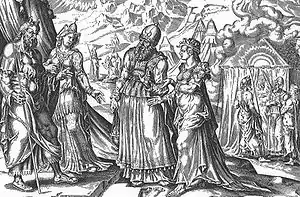Tharbis
Tharbis (alternatively Adoniah[1][2]), according to Josephus, was a Cushite princess of the Kingdom of Kush, who married Moses prior to his marriage to Zipporah as told in the Book of Exodus.[3]
Tharbis | |
|---|---|
| Born | Kingdom of Kush |
| Spouse(s) | Kikianus Moses |
| Parent(s) | Merops |
Family
Tharbis is speculated to have been the daughter of King Merops,[4] or the widow of Kikianus.[1]
According to Josephus
According to the first-century Romano-Jewish scholar Josephus, in Moses' early adult life, he had led the Egyptians in a campaign against invading Ethiopians and defeated them. While Moses was besieging the city of Meru,[4] Tharbis watched him lead the Egyptian army from within the city walls, and fell in love with him. He agreed to marry her if she would procure the deliverance of the city into his power. She did so immediately and Moses promptly married her.[5] The account of this expedition is also mentioned by Irenaeus.[6]
After the war, when Moses sought to return to Egypt – Tharbis is said to have resisted and insisted that he remain in Ethiopia as her husband. He then, being "most skilful in astronomy", cast two rings; one which caused the wearer to become forgetful, and the other to cause the wearer to remember all. He gave the first ring to Tharbis, and wore the second himself, and waited for her oblivious nature to lose interest in retaining him as a husband – and when she had forgotten her love for him, he returned to Egypt alone.[7] Some have suggested this period may have started when Moses was 27, and that he remained with Tharbis for forty years;[8] although this number contradicts the traditional sources which suggest that Moses killed an Egyptian overseer when he was approximately 40 years old himself.[9][10][11]
Theories

Some have suggested that this story is an invention, arising from the "enigmatic" verse in Numbers 12:1 that states "Miriam and Aaron spoke against Moses because of the Cushite woman whom he had married".[12] Miriam is punished for her rebuke of her brother by being afflicted with leprosy.[13] Moses is depicted with an Ethiopian wife in a 17th-century painting by Jordaens.
It is also suggested that Artapanus of Alexandria may have concocted the story "to impress his pagan audience" with "such a love story".[14]
In fiction
In 1937, Amy Redpath Roddick published an 80-page "poetic drama" telling a fictionalised account of the life of Tharbis.[15][16]
Tharbis is portrayed in Cecil B. DeMille's 1956 biblical-epic The Ten Commandments. In the film, she appears briefly and is not Moses's wife.[17]
References
- Book of Jasher, 23.5-25.5
- Dewey M. Beegle, "Moses," The Anchor Bible Dictionary, 6 vols. (New York: Doubleday, 1992), vol. 4, p. 917.
- Flavius Josephus, Jewish Antiquities, Book II, Chapter 10
- Beaumont, Comyns. "The Riddle of Prehistoric Britain",1994. p. 107
- "Antiquities of the Jews page 61".
- "Fragments from the Lost Writings of Irenaeus, XXXII".
- Raleigh, Sir Walter, The History of the World: Section IV 'Of Moses' flying out of Egypt, 1829 edition
- Yashar Shemot, Midrash to the Pentateuch, 11th century
- Exodus 2:11-21
- Inglis, James. "The Witness", 1871. pp. 30
- Bostwick, Henry. "Lectures Upon Portions of History", 1838. p. 29
- Hays, J. Daniel. Did Moses Marry a Cushite?
- Book of Numbers, Chapter 12. v. 1-10
- Feldman, Louis H. "Jew and Gentile in the Ancient World", 1996. p. 547
- Roddick, Amy Redpath. "Tharbis", 1937 OCLC 13114790
- "University of Toronto Quarterly". University of Toronto Press. 17 April 2018 – via Google Books.
- Meyer, Stephen C. (27 November 2014). Epic Sound: Music in Postwar Hollywood Biblical Films. Indiana University Press. ISBN 9780253014597. Retrieved 17 April 2018 – via Google Books.